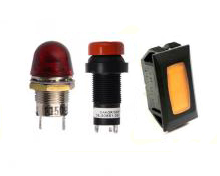
Commercial rectangular panel mount and mil spec applications with various configurations including Press-to Test, Watertight, EMI Shielded and Dimmable
The Benefits of Press-to-Test Indicator Lights in Modern Electronics
In today's fast-paced world, electronics play an integral role in our daily lives. From military and aviation platforms to the complex machinery in other high reliability industries, electronic components are everywhere. Ensuring the proper functioning of these components is paramount, which is why press-to-test indicator lights have become invaluable in the world of electronics.
Press-to-test indicator lights, often referred to as pilot lights or push-to-test buttons, serve a vital role in various applications. These small yet powerful components offer a range of benefits that contribute to the safety, functionality, and efficiency of electronic systems. In this article, we'll explore the advantages of press-to-test indicator lights and why they have become indispensable in modern electronics.
1. Quick and Convenient Testing:
Press-to-test indicator lights provide a simple and efficient way to check the status of electronic circuits or equipment. With a quick push of a button, users can verify if a circuit is functioning correctly without the need for additional tools or equipment. This feature is particularly valuable in industries where downtime is costly and every minute counts.
2. Enhanced Safety:
Safety is a top priority in any electronic system, especially in industrial settings. Press-to-test indicator lights help in maintaining safety by allowing operators to confirm that a circuit or safety mechanism is operational before performing any potentially hazardous tasks. This pre-check minimizes the risk of accidents and enhances overall workplace safety.
3. Clear Visual Indication:
Press-to-test indicator lights provide clear visual feedback. They are available in a range of colors and can be equipped with symbols or labels to indicate specific conditions or functions. This visual clarity makes it easy for operators to understand the status of a circuit or device at a glance, reducing the chances of misinterpretation.
4. Versatility:
These indicator lights are versatile and adaptable to various applications. Whether used in machinery, control panels, or consumer electronics, press-to-test indicator lights can be customized to meet specific requirements. Their compatibility with different voltages and circuit configurations makes them a flexible choice for a wide range of industries.
5. Diagnostic Capabilities:
In addition to basic functionality checks, some press-to-test indicator lights come with built-in diagnostic features. These advanced indicators can provide more detailed information about the status of a circuit, enabling quicker troubleshooting and maintenance.
6. Compliance with Standards:
Press-to-test indicator lights are often designed to meet industry-specific standards and regulations. Using these lights ensures that electronic systems and equipment adhere to safety and quality standards, which is crucial in highly regulated industries such as healthcare and aerospace.
In conclusion, press-to-test indicator lights are a vital component in modern electronics. Their ability to offer quick and convenient testing, enhance safety, provide clear visual indication, and adapt to various applications make them an essential choice military, aviation, and industrial machinery. As technology continues to advance, press-to-test indicator lights will likely play an even more significant role in ensuring the reliability and safety of electronic systems.